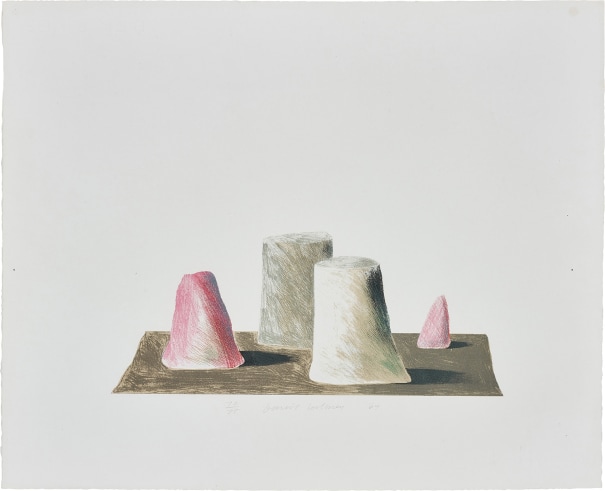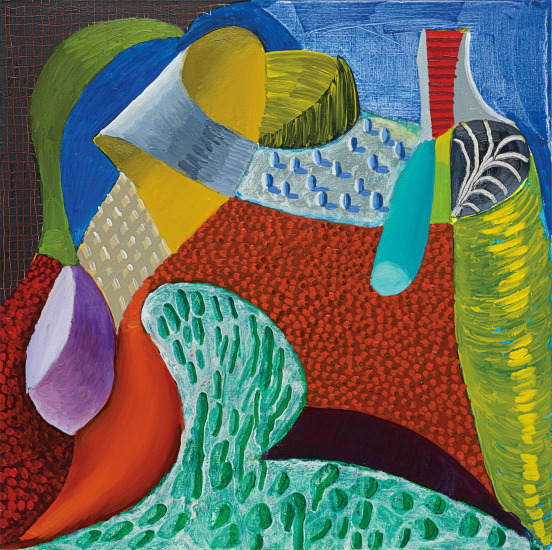12 David Hockney The Gate signed, titled and dated "David Hockney 2000 The Gate" on the reverse oil on canvas 60 x 76 in. (152.4 x 193 cm.) Painted in 2000.
Provenance Galerie Lelong, Paris L.A. Louver, Los Angeles Private Collection, Italy Private Collection, New York (acquired from the above) Exhibited Paris, Galerie Lelong, David Hockney Close and Far, November 8 - December 22, 2001, n.p. (illustrated) Los Angeles, LA Louver, August 2002, August 1 - 31, 2002 Literature Lawrence Weschler, True to Life: Twenty-Five Years of Conversations with David Hockney Berkeley, 2008, p. 114 (illustrated) C. Silvia Weber, ed., David Hockney/Nur Natur/Just Nature, exh. cat., Kunsthalle Würth, 2009, pp. 61, 223 (illustrated) Catalogue Essay David Hockney’s The Gate, executed on a grand scale in his high-keyed palette, is a stunning domestic landscape with allusions to his own history as well as his artistic predecessors. Skewing perspective with electrifying color, Hockney depicts a portrait-by-proxy, the illustration of the home as a reflection of the painter and the occupant. The Gate highlights Hockney’s myriad influences and interests, ranging from stage-set design to photography, digital media to Old Master painting, Los Angeles to London. Hockney spent his entire career looking—focusing his art on how to relate what he sees and how he sees it to the viewer. The Gate greets the viewer with great immediacy. The slate grey staircase gradually unfurls down to the gate as the pink wall to the left and green hedge to the right funnel the viewer into a faux-illusionistic space that hardly exists within the picture plane, but which is innately understood by the viewer to exist in reality. The tangled web of branches and pointillist canopy of leaves form a sheltering umbrella. Hockney has not merely taken a snapshot of a given scene but imbued it with a particular sense of experiential sharing. “I am constantly preoccupied with how to remove distance so that we can all come closer together, so that we can all begin to sense we are the same, we are one,” Hockney said in 1993. Hockney’s art is not “realistic” in the sense that it purports to portray chromatically accurate images in perspective. Rather, it has a perception of a place that is a direct reflection of his sense of that place. Like Henri Matisse’s Fauvist Road at Biskra, 1906, Hockney uses colors that may at first seem unnatural to the viewer; to Hockney, though, it is veritably there in the original scene. Matisse’s color was derived from the immediacy of the glance, the intensity of the sun within the scene, whereas Hockney’s is drawn out of intense looking and reflection. And yet the end result is the same – a conflation of figuration and abstraction resulting in a more expressive reality. There is a humanism in these pictures that is pure Hockney. The artist painted The Gate when he was visiting the British countryside of his youth. But the influence of his many years in Los Angeles is clearly reflected in the work, much as it is in pictures like his Mulholland Drive: The Road to the Studio of 1980. We see many of the same technical achievements in The Gate—a deeply personal setting (whether an intimate garden gate or the approach to his studio) and a multi-tiered perspective arranged to create a visual narrative. The eye is drawn in just as the viewer might move in the physical world. The Gate is a masterwork of Hockney’s later oeuvre, looking both backwards and forwards to his next seminal series of paintings executed in the Wolds of Great Britain, which were met with similar acclaim. Hockney is arguably Britain’s most accomplished painter, and works such as The Gate make it readily apparent why. Read More
12 David Hockney The Gate signed, titled and dated "David Hockney 2000 The Gate" on the reverse oil on canvas 60 x 76 in. (152.4 x 193 cm.) Painted in 2000.
Provenance Galerie Lelong, Paris L.A. Louver, Los Angeles Private Collection, Italy Private Collection, New York (acquired from the above) Exhibited Paris, Galerie Lelong, David Hockney Close and Far, November 8 - December 22, 2001, n.p. (illustrated) Los Angeles, LA Louver, August 2002, August 1 - 31, 2002 Literature Lawrence Weschler, True to Life: Twenty-Five Years of Conversations with David Hockney Berkeley, 2008, p. 114 (illustrated) C. Silvia Weber, ed., David Hockney/Nur Natur/Just Nature, exh. cat., Kunsthalle Würth, 2009, pp. 61, 223 (illustrated) Catalogue Essay David Hockney’s The Gate, executed on a grand scale in his high-keyed palette, is a stunning domestic landscape with allusions to his own history as well as his artistic predecessors. Skewing perspective with electrifying color, Hockney depicts a portrait-by-proxy, the illustration of the home as a reflection of the painter and the occupant. The Gate highlights Hockney’s myriad influences and interests, ranging from stage-set design to photography, digital media to Old Master painting, Los Angeles to London. Hockney spent his entire career looking—focusing his art on how to relate what he sees and how he sees it to the viewer. The Gate greets the viewer with great immediacy. The slate grey staircase gradually unfurls down to the gate as the pink wall to the left and green hedge to the right funnel the viewer into a faux-illusionistic space that hardly exists within the picture plane, but which is innately understood by the viewer to exist in reality. The tangled web of branches and pointillist canopy of leaves form a sheltering umbrella. Hockney has not merely taken a snapshot of a given scene but imbued it with a particular sense of experiential sharing. “I am constantly preoccupied with how to remove distance so that we can all come closer together, so that we can all begin to sense we are the same, we are one,” Hockney said in 1993. Hockney’s art is not “realistic” in the sense that it purports to portray chromatically accurate images in perspective. Rather, it has a perception of a place that is a direct reflection of his sense of that place. Like Henri Matisse’s Fauvist Road at Biskra, 1906, Hockney uses colors that may at first seem unnatural to the viewer; to Hockney, though, it is veritably there in the original scene. Matisse’s color was derived from the immediacy of the glance, the intensity of the sun within the scene, whereas Hockney’s is drawn out of intense looking and reflection. And yet the end result is the same – a conflation of figuration and abstraction resulting in a more expressive reality. There is a humanism in these pictures that is pure Hockney. The artist painted The Gate when he was visiting the British countryside of his youth. But the influence of his many years in Los Angeles is clearly reflected in the work, much as it is in pictures like his Mulholland Drive: The Road to the Studio of 1980. We see many of the same technical achievements in The Gate—a deeply personal setting (whether an intimate garden gate or the approach to his studio) and a multi-tiered perspective arranged to create a visual narrative. The eye is drawn in just as the viewer might move in the physical world. The Gate is a masterwork of Hockney’s later oeuvre, looking both backwards and forwards to his next seminal series of paintings executed in the Wolds of Great Britain, which were met with similar acclaim. Hockney is arguably Britain’s most accomplished painter, and works such as The Gate make it readily apparent why. Read More
.jpg)
.jpg)




.jpg)
.jpg)
.jpg)
.jpg)
.jpg)

Try LotSearch and its premium features for 7 days - without any costs!
Be notified automatically about new items in upcoming auctions.
Create an alert